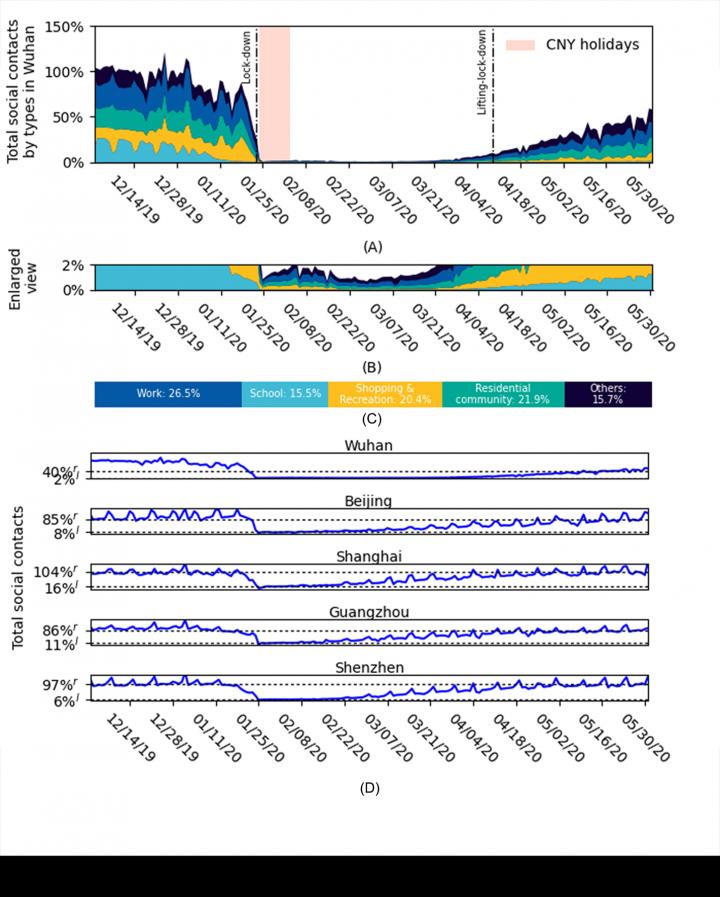
Credit: WorldPop, University of Southampton
A combination of robust vaccination programmes and strict physical distancing rules could avoid recurring peaks of COVID-19 without the need to rely on stay-at-home restrictions, according to a new study by epidemiologists and demographers from WorldPop at the University of Southampton, in collaboration with The Chinese University of Hong Kong.
This research used anonymised mobile phone geolocation data with epidemiological and coronavirus case data from China to model the potential impact of vaccination and physical distancing on virus transmission. They predicted the effect of different combinations of interventions on low, medium and high density cities in the country.
The impact of physical distancing in containing future resurgences of COVID-19 depends greatly on the intensity of measures, population density, and the availability of vaccines across geographical areas and time. The researchers set out to gain a greater understanding of the relationship between these factors.
The findings are published in the journal Nature Human Behaviour.
The team predicts that in most cities, vaccination programmes and physical distancing combined will be enough to contain virus resurgence without the need to greatly restrict population mobility. Containment in this study was defined as maintaining a low transmission rate, or ‘R’ below one.
The researchers report cities with medium and high density populations will need both vaccination and distancing to prevent future intense waves of COVID-19, until herd immunity is reached. However, they suggest cities with low populations and effective vaccination could fully interrupt transmission without the need for physical distancing. In all cities, full ‘stay-at-home’ lockdowns would no longer be necessary.
The team’s results also suggest strong physical distancing interventions implemented for short periods of time may be more effective than mild, longer term ones.
The author and spatial epidemiologist, Dr Shengjie Lai, Senior Research Fellow in Geography and Environmental Sciences at the University of Southampton comments: “Our research provides a framework and set of outputs that can be used by policy-makers and public health authorities to identify appropriate levels of intervention to keep COVID-19 outbreaks in check over time. Although our study was based on data from China, our methods and findings are applicable to cities worldwide with similar levels of population density and social contact patterns.”
Director of WorldPop, Professor Andy Tatem, added: “Previous studies have assumed that when people reduce mobility, they proportionately reduce their social contacts, but this isn’t necessarily the case and as more SARS-CoV-2 vaccines come online, there is an urgent need to understand the relationship between these factors, so we can adjust and tailor interventions and open up sections of society in a safer way.”
The researchers recognise some limitations to their study, for example, the absence of data on the contribution of handwashing and face masks and challenges of vaccine supply, but emphasise that their approach can be quickly adapted to provide near real-time data to address emerging, time critical needs.
###
Notes to Editors
1) The paper ‘Integrated vaccination and physical distancing interventions to prevent future COVID?19 waves in Chinese cities,’ is published in the journal Nature Human Behaviour (DOI: https:/
2) Mobility and social contact index data used in the study were aggregated and provided by Tencent, the largest social media company in China – covering 70 percent of the population in the mainland of the country. Epidemiological and coronavirus case data was sourced from records covering the Chinese city of Wuhan.
3) The University of Southampton drives original thinking, turns knowledge into action and impact, and creates solutions to the world’s challenges. We are among the top 100 institutions globally (QS World University Rankings 2021). Our academics are leaders in their fields, forging links with high-profile international businesses and organisations, and inspiring a 22,000-strong community of exceptional students, from over 135 countries worldwide. Through our high-quality education, the University helps students on a journey of discovery to realise their potential and join our global network of over 200,000 alumni.
http://www.
4) For more information on COVID-19 work being undertaken by WorldPop at the University of Southampton visit:
https:/
5) For more about the The Chinese University of Hong Kong visit:
https:/
For further information and interviews contact:
Charles Elder,
Media Relations, University of Southampton.
Tel: 07879 431666
Email: [email protected]
http://www.
Follow us on twitter: http://twitter.
Like us on Facebook: http://www.
Media Contact
Charles Elder
@unisouthampton
44-078-794-31666
Original Source
https:/
Related Journal Article
http://dx.




